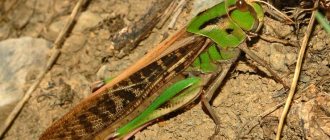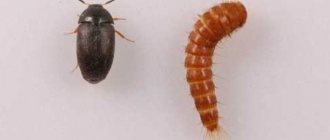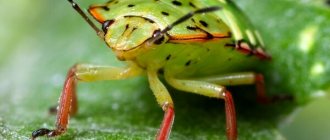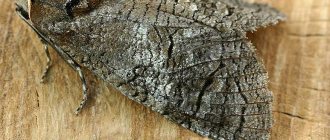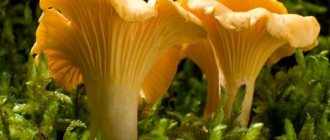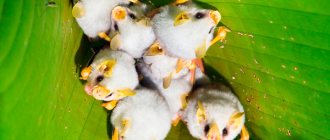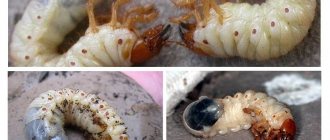Stages of development of the cockchafer
In early spring, when the rain begins
the leaves of the birch and then the oak descend, and in the evenings May beetles begin to fly around.
They emerge from the pupa and fly out of the ground when the soil warms up to 10-14 degrees Celsius. This usually occurs in the month of May, hence the name of the beetle. During the day they sit on trees and eat leaves. For 1 – 2 months, the beetles feed on the leaves and flowers of trees, flying from one tree to another, and mate. The female cockchafer is ready for reproduction two to three weeks from the moment of departure. After mating, she burrows into the soil to a depth of 15 to 25 cm to lay eggs. It flies out of the ground, mates again, lays eggs again. And so up to 4 times it lays in groups of 5 to 20 eggs, up to 70 in total. After this she dies.
The time it takes for the larvae to hatch from the eggs depends on the soil temperature and is one to one and a half months (4 to 6 weeks). The larvae grow and develop in the soil for three to four years. With the onset of autumn and colder weather, they begin to burrow deeper into the ground and can go to a depth of up to 1.5 meters. With warming in spring, the larvae again rise higher, closer to the surface. A warm and humid environment is comfortable for beetles; 24 degrees Celsius is the optimal soil temperature for them. In summer, beetles are found at a depth of 10–20 cm, but during drought they can go deeper.
By the end of summer or the beginning of autumn, motionless pupae turn into beetles. The beetles remain in the soil over the winter, and in early spring they rise to the surface and fly out of the ground. Under the ground, they gnaw their own passages.
So, the cockchafer has the following stages of development:
- eggs
- larva
- doll
- adult cockchafer.
Nutrition of cockchafers and their larvae and harm to humans
For adult beetles, the most delicious leaves of trees and shrubs are the leaves of cherries, apricots, sweet cherries, plums, apple trees, currants, and sea buckthorn. They also eat flowers and fruit ovaries. They will also happily eat the leaves of non-fruit trees - birch, maple, aspen, poplar, oak, and willow.
Young larvae of the May beetle are initially harmless for the first year, as they feed on humus, then, having grown stronger in the second or third year of life, they eat the roots of plants, which can lead to their death.
The May beetle larva eats the roots of strawberries, various vegetables, corn, also eats potato tubers, roots of lawn grass, eats the roots of fruit trees and shrubs, as well as the roots of pine, cedar, birch, larch, and spruce trees. Every year the larvae become more voracious. If a two-year-old larva eats the roots of a two-year-old pine tree for a week, then a three-year-old chafer larva will eat them in one day. The chafer larva feels good in acidic soil. The optimal temperature for it is 20-25 degrees Celsius, humidity is 6-7%. The cockchafer larva dies at temperatures below minus 5 degrees and above 35 degrees Celsius.
Natural enemies of cockchafers
May beetles do not have many natural enemies. Not every bird can cope with an adult beetle. These are rooks, starlings, sparrows. The larva in the depths of the earth is well protected, try to get it. It can become prey for moles and mice.
May beetles and especially their larvae are undoubtedly one of the most voracious pests of our dachas, gardens, and vegetable gardens, and they are also very difficult to fight. Knowledge of the conditions and stages of development of the cockchafer will help you decide on ways and means to combat this pest.
Life of the cockchafer at home
The cockchafer is far from the most popular pet. Most often, an inquisitive child can bring it into the house to watch the insect and feed it. Such a neighborhood is very dangerous for summer residents, because the beetle can quickly move into the garden and cause great harm to all plants.
If you nevertheless decide to have such an unusual pet, you need to place it in a pot of soil. You need to feed it the freshest leaves from bushes and trees. He will not eat dry leaves.
To prevent beetles from breeding in your garden, you can hang several birdhouses on the trees. Birds will catch insects and protect trees from their harm.
Who eats Khrushchev?
May beetles themselves are a favorite treat for domestic birds : chickens, geese and turkeys. Wild forest animals, such as hedgehogs or moles, also love to eat such food. Birds do not fly past the insect, catch it and eat it, thereby protecting garden plants.
Experienced fishermen catch beetles and use them as bait for fishing. River fish bite well on this bait.
The flight of the cockchafer is one of the first signs of the onset of spring warmth. Watching them is a pleasure for children and adults. But we must remember that just a few beetleworms can leave a gardener without a harvest of his favorite vegetables and fruits. Therefore, you need to try to control their reproduction in your summer cottage, especially when getting such a pet at home.
Basic description of the pest
May lily of the valley composition, properties, benefits and harms, use and contraindications
May beetles, also known as May beetles, are insects of the order Coleoptera, family Lamelidae, type - arthropods, inhabit Europe and Asia. In some years, they caused enormous damage to agricultural activities. Thanks to the widespread use of pesticides, their population has decreased significantly, and in some areas they have completely disappeared. In the 1980s, the use of a number of chemicals was banned, and their number began to increase. The larva of the cockchafer, a photo of which you will see below, causes enormous damage to plants. Read on for ways to combat the pest.
This insect is quite large in size - up to 31.5 mm. The elongated oval or broad oval body is quite protruding forward, black or red-brown, the elytra are mainly red-brown or yellow-brown in color. The head and pronotum sometimes have a faint greenish tint. The sides of the ventral part have white triangular spots of small dense hairs, mostly large and clear, rarely small and blurred.
The body has dense small or shallow punctures and small adjacent hairs or hair-like scales of a whitish, yellowish or grayish color. The hairs and scales are of medium density (in young individuals that have just become beetles), and are very dense, hiding the main background. On the head and pronotum there are usually the longest protruding hairs, mainly collected in longitudinal stripes. The underwings also often contain the sparse, longest, bristling hairs. The extreme segment of the maxillary palps is elongated, pointed at the apex, slightly curved, and has an indentation at the top.
The antennae have ten segments, the third palp is elongated, the male has a large, significantly curved club, which consists of 7 identical plates, the female has 6. Large, semi-oval, very smooth, shiny scutellum, sometimes with relatively dense punctures with small hairs or scales . The elytra are oblong-oval, with 5 narrow ribs, the distance between them is densely dotted and wrinkled. The posterior section of the abdomen is large, inclined, triangular or blunt in shape, elongated in the form of a process. In females the process is always shorter, in males it is more developed and elongated.
The chest is covered with thick and long yellow hairs. The abdomen is covered with both small, non-protruding hairs and scales, and bristling long, frequent or sparse hairs, sometimes they are absent. There are also hairs on the legs, longer on the thighs. On the outside of the fore tibia there are two, rarely three, teeth.
It will be useful to read:
Ways to destroy spider mites There are many different insects that harm garden and vegetable crops. To destroy some...
What do the cockchafer and its larvae eat in nature?
First of all, the children and I found out what kind of food the insect prefers in its natural environment.
During the first summer, the furrow beetle - the larva of the cockchafer - feeds on the thin roots of herbaceous plants. The next season, she chooses coarser food, gnawing young shoots of the underground part of trees and shrubs. After another year, her jaws can cope with absolutely all the “delicacies” underground. If a beetle larva is lucky enough to “settle” in a garden or field, it will gnaw on any root crops: potatoes, carrots, beets and dahlia bulbs. This malicious pest often spoils the crops in our area.
This is interesting! The importation of beetroot into North America is strictly prohibited by law. Here the cockchafer has no natural enemies. A voracious insect can cause an environmental disaster.
The adult cockchafer feeds on solid plant food and destroys large quantities of young greenery, flowers and ovaries of all plants in the surrounding area. During the years of mass flight, completely eaten branches can be seen on trees “captured” by Khrushchev. Coniferous and deciduous crops, but especially fruit crops, suffer from pest attacks.
Western May beetle Melolontha melolontha L.
How to get rid of bark beetle in a wooden house - folk remedies
The Western May beetle is a fairly large beetle, 23-31 mm long, with a powerful, strongly convex body. The main color is black, the elytra, legs and antennae, palps and pygidium are light brown to black-brown. Characterized by strong color variability. The rather small head is elongated into a powerful shield of the pronotum, which is covered especially on the sides with thick light hairs. On the head there is a pair of fan-shaped antennae, which in the male are completed with 7 leaf-shaped plates, wider and 2 times larger than in the female, which has only 6 of them. The brown elytra have 4 ribs. White triangular spots are clearly visible on the sides of the abdomen. The last segment of the abdomen is elongated into a chisel-shaped protrusion - the pygidium, which in the male is longer, more blunt and slightly backward; in the female it is shorter, more pointed and more adjacent to the body, almost vertical. The tibia of the female's front leg is widened and has jagged edges. Western May Khrushchev is distributed throughout most of Europe, in the east it is found in the European part of the former USSR, the distribution border leads from Latvia to Kharkov, then to Zaporozhye and Odessa. The areas of greatest damage, however, are in central Europe.
a — damage to adult beetles on a young oak branch; b - damage to larvae on the roots of a young oak tree; c — end of the abdomen of the May beetle larva; d - Khrushchev egg; e - first, second and third instars of larvae. Khrushchev eggs are oval, approximately 3 x 2 mm in size, dirty white. The larvae are fleshy, whitish-yellow, and shaped like the letter “C”. The head is brown with four-part antennae and strong jaws. Has 3 pairs of thoracic legs. The abdomen consists of 10 segments, the last two of which are massive. The last segment has two parallel longitudinal rows containing 22-30 setae. The larvae have only three instars, which differ in the width of the head chambers (first instar = 2.5 mm, second instar = 4 mm, third instar = 6 mm). The pupa is free, yellowish.
Western May Khrushchev (photo: V.L. Potapova)
Young chafer beetles are found in the soil already at the end of summer and overwinter there until next spring. In the southern regions they usually appear in the second half of April until the beginning of June. In the northern regions, Khrushchev appears from mid-May to the end of June. They fly along the edges of deciduous plantations and mate during additional feeding. Fertilized females with mature eggs stop feeding and always fly along the same paths to open areas for laying eggs. They prefer light, warm soils with sparse soil cover. At a depth of 10-40 mm, 10-30 eggs are laid and return to feed again. This is repeated approximately 3 times. Adults feed along the edges of forest plantations, up to about 50 m deep into the forest; they eat leaves of oak, beech, maple, elm, hazel, poplar, willow, walnut, as well as leaves of fruit trees. The larvae emerge after 40-50 days, at the end of June - July. First they feed on humus particles, then they also eat roots. In northern and central Europe, a 4-year development period predominates; in the warmer southern regions, a 3-year development period prevails. The most significant damage is caused by damage to the roots and thicker roots by second and third instar larvae from May to September. Young spruce and pine trees are most sensitive to damage, and die when the damage is more severe.
Types of cockchafers
There are more than 60 varieties of Khrushchev, but some species are more common. These include:
- The eastern May beetle is a brown insect, the females are much larger than the males. During the mating period, males can change their color; a distinctive feature of this type of insect is the presence of pygidia, which are large, thin and have a kind of seal at the end. The insects live in Northern Europe. Khrushchev feed mainly on coniferous trees.
- Western Khrushchev - has a convex body, body length reaches 30 mm. Insects appear only after the onset of constant warmth towards the end of May. The color of the insect is dark brown, but in some cases there may be black spots. The beetle feeds mainly on deciduous trees and young grass. Most often found in Russia and Ukraine.
- The Caucasian beetle is a brown insect, the abdomen is covered with white hair, which does not adhere to the body, but can stick out in different directions. Distinctive features of the insect: a small pygidium, which has a rounded shape. You can most often find such a Khrushchev in Germany and Austria.
- March Khrushchev - has an oblong body that reaches up to 25 mm in length. A distinctive feature from other types of Khrushchev is the pygidium, which has a triangular shape and is practically invisible under the wings. The body of the Khrushchev is brown with small white patches. Most often found in Uzbekistan and Tajikistan.
- Melolontha kraatzi - the insect has an elongated body, up to 25 mm in size. The body of the Khrushchev has a cinnamon color with a brown tint. There are white hairs on the wings, which are arranged in the form of stripes. You can meet such an insect in Iran and Azerbaijan.
Let's celebrate ! All species have common features and feed on vegetation. The life span of insects is up to 45 days. Khrushchi fly quickly and at the same time make a specific buzzing sound.
Phases of development
Weevil on strawberries Weevil on strawberries
The beetles become active in June or July, and their flight lasts up to 1.5 months.
The behavior of the pest depends on its habitat. Thus, those living in the forest eat tree leaves or pine needles during daylight hours. Here they choose not only trees, but also thickets of tall grass and bushes. Adults living in the steppe prefer to hide in the soil during the day. Their activity becomes more active only at dusk, but continues throughout the night. As a rule, the males take flight, and the females wait for them on the plants.
Mating of beetles begins a week after additional feeding. Females lay eggs in the soil, each capable of producing from 20 to 30 eggs. The period of embryo development depends on temperature and environmental conditions, and in different regions it lasts different times: from 4 to 6 weeks.
The larva lives in the upper layers of the soil and eats plant roots. It goes into the deep layers of the soil to spend the winter. The larva overwinters once or twice.
The pupation period begins in early May, and at this time the larva rises closer to the surface, to a depth of approximately 15 cm. Pupation takes from 1 to 2 months, so some adults may appear in July.
Lifestyle and habitat
Khrushchi are typical representatives of the Melolont genus, living in Asia and the northern part of Europe. The life cycle of this arthropod averages 3 years, during which it undergoes a series of transformations.
- In the first year of life, a larva hatches from an egg laid by an adult female. It originates in the upper layers of the soil and develops throughout the warm season. To survive the winter, the caterpillar that has formed over the summer burrows deeper into the soil and waits out the cold. In the first year of its existence, the cockchafer larva feeds on the small roots of grasses or cultivated plants.
- The second year of Khrushchev development also takes place underground. But the individual has already reached a more impressive size (up to 5 centimeters) and has a good appetite. In the second year of life, it is already able to eat the root system of an adult tree, thereby causing significant harm to the plants.
- During the third year, the large caterpillar turns into a beetle, moving to the final stage of its life cycle - the adult. The adult insect remains underground for some time and only comes to the surface to mate. In dry and warm weather, cockchafers fly around trees and over meadows, looking for a mate. The male dies soon after the mating season ends, and the female dies after she lays eggs in the ground.
The beetle in the adult stage under natural conditions eats succulent leaves, shoots, and buds of trees and shrubs growing in temperate climatic zones. The diet of arthropods also includes cultivated plant varieties, for example, apple trees, grapes, pears or plums.
Due to the damage that pests cause to agriculture, chafers and their larvae are actively exterminated, artificially reducing the population.
Pest control methods
A colony of beetles often coexists with other pests, for example, chafers, and their joint actions increase the damage caused to the garden. In order to prevent outbreaks of a serious increase in the number of beetles, it is recommended to monitor it throughout the summer and note the period of emergence of adult individuals.
To find out the number of the pest, in the first month of summer, soil excavations are carried out and the population density of the larvae is studied. The same actions are recommended to be carried out at the end of summer, in August.
Methods for killing a beetle
The process of protecting the garden and vegetable garden from June beetle must be comprehensive: it is necessary to protect the roots of young plants with organophosphorus compounds, treat the soil with special means, and destroy adult beetles during the summer using chemicals.
Folk methods of fighting Khrushchev
You can destroy the larvae of common beetroot on the site by treating the contaminated soil with herbal infusions:
- A bucket of water is poured with 500 g of sunflower flowers or 1 kg of dried acacia bark. Leave for 3 days, filter.
- ½ bucket of poplar leaves is poured with a bucket of boiling water and put on fire for a quarter of an hour. Leave the broth to infuse for 3 days.
- 300 g of wormwood (leaves, stems) are combined with 200 g of ash, a bucket of hot water is added to the mixture, and left to infuse for several hours before use.
A good result will be obtained by alternating an iodine solution and an infusion of husks:
- 15 drops of iodine are added to a bucket of water, and the soil around the plants is watered with this liquid;
- 100 g of garlic or onion peels are poured into a bucket of warm water, covered with a lid, left for 3 days, and then diluted in half with water and watered at the roots of the plants.
Traps
If there is a large accumulation of June beetle in a certain place in the garden, simple traps will help reduce the number of beetles:
- Adhesive anti-fly tape is glued to a board or any other surface and installed in the place where the pests are most numerous.
- Adult beetles can be caught using devices made from a plastic glass or bottle - the container is filled with water or kvass diluted with jam and placed next to the insects. Beetles that get into the water from the bottle are removed and destroyed daily.
Chemicals
To significantly reduce the population of non-Khrushch larvae, you can use special preparations: “Pochin”, “Antikhrushch”, “Zemlin”, “Aktara”, “Bazudin” and others.
Biological products
If a pest eats the roots of vegetable or fruit and berry crops, it is best to fight it with biological preparations - they cope with the task without causing harm to the future harvest.
Among the most popular: Metarizin, Kurkliai, Nemabakt and others.
Nitrogen
An increased nitrogen content in the soil has a detrimental effect on beetles. You can increase its concentration by scattering chicken manure or planting nitrogen-producing plants (beans, lupine, white clover) on the site.
It is advisable to carry out deep digging of the earth in areas where the beetle is spread and timely removal of weeds.
Only this approach can reliably protect trees and plants from pest attack.
Folk methods of combating cockchafer larvae
- Gardeners consider digging up the soil to be one of the most effective and safest ways to combat cockchafer larvae, after which the pests are collected by hand and destroyed. If you have pet chickens, you can let them out on the ground and let them look for those larvae that you have not noticed.
- Starlings are very good at destroying larvae. However, before hanging birdhouses on trees, keep in mind that not only insect pests are of great interest to these birds, but also some fruit and berry plants.
- If you suddenly have a hedgehog on your property, do not rush to drive it away: it will also help get rid of the larvae of the cockchafer, as well as many other harmful insects.
- Many gardeners recommend planting white clover around tree trunks. The roots of this plant are home to bacteria that absorb nitrogen, which turns the soil into an unsuitable environment for beetles. The larvae are not too fond of being in the vicinity of cruciferous plants: mustard, turnips, turnips.
- Some gardeners help get rid of the larvae by treating the beds with an iodine solution or a solution of ammonia. You need to dilute 15 drops of iodine or half a tablespoon of alcohol in ten liters of water, and in the spring pour the solution into the recesses between the rows of plants. Try not to get the solution on the leaves. When planting new plants, treat the soil in advance.
- Another popular way to combat larvae is an infusion of onion or garlic peels. One hundred grams of husk should be infused in ten liters of water for five days, after which the infusion is diluted with water in the same amount and poured under the plants.
Description of the pest
An adult beetle reaches a length of up to 19 mm. The color of the shell and head are dark brown, and the legs, antennae and edging of the chest shield are yellowish-red. The elytra are lighter, their color is closer to yellow. They shine, and along them there are 4 stripes.
The entire chest of the beetle is covered with long, light-colored hairs; the abdomen also has hairs, but they are shorter. The antennae consist of 9 segments.
The female can be distinguished by shorter and sparse hairs on the body.
The eggs laid by the female June beetle are white, almost round, slightly elongated. For laying, females prefer to choose abandoned or virgin areas overgrown with wild cereals.
The head of the larvae is red, shiny, without eyes. The body is white, curved, and has 3 pairs of legs. The length of the larva can reach 52 mm.
The pupa is light in color, but begins to darken before the adult emerges.
Interesting facts about the cockchafer
- An interesting feature of cockchafers is the fact that insects fly contrary to all the laws of aerodynamics: these beetles have too little lift coefficient, and, according to experts, they should not fly at all!
- The cockchafer is an extremely purposeful insect, and it is almost impossible to confuse it. Having set its goal at a certain hill, the beetle will fly in a given direction no matter what. You can catch the beetle and release it in another place, try to disorient it using a chemical or physical method, but once in the wild, the cockchafer will still return to the set course and reach its goal.
- Possessing an exceptional appetite, the May beetle larva of the 3rd year of life is capable of completely destroying the roots of a two-year-old pine tree in one day.
- In Andersen's world-famous fairy tale “Thumbelina,” the cockchafer is one of the contenders for the hand and heart of the main character.
Photo by: jp hamon
- Next publication Spider wasp (Argiope Brünnich)
- Previous publication Lemur
Who eats cockchafers?
May beetles can cause irreparable damage to vegetation, especially if they have settled in large numbers. Khrushchi can act as food for other animals.
Khrushchev and larvae can be a delicacy for the following animals:
- poultry (chickens, ducks);
- hedgehogs and moles;
- wild animals;
- birds;
- fish;
- the bats.
Let's celebrate! The larvae are most often eaten by moles and other types of insects, such as mole crickets.
Reproduction
The beetles lay eggs in the soil to a depth of 20–40 cm, in groups of 5–20 pieces. They prefer warm soils with liquid soil cover. The eggs are oval, white, 2x3 mm in size. After 24 - 25 or 40 - 50 days, depending on the soil temperature, small dirty white insect larvae appear. The larvae of subsequent centuries are white, large, C-shaped. The head is brown, with yellow-brown jaws. On the anal segment of the abdomen there are 2 rows of 25 - 30 small conical bristles. The last instar larvae reach a length of 45 - 65 mm. Larvae of the first instar feed on humus, while larvae of later instars feed on dead and living roots of various plants. In northern and central Europe the generation is 4 year old, in the warm southern regions it is 3 year old. Pupation of the last instar larvae occurs in June-July in an earthen cradle. The pupa is free, yellowish. The pupal stage is 30 - 40 days. The imago overwinters. In dry years with hot summers and autumns, a small number of beetles may emerge in the fall.
Types and photos of the pest
Various types of May beetle inhabit almost all of Europe, Asia Minor, the Caucasus, most of the Siberian taiga and Central Asia, Syria, northern Iran, India, Japan, China, also Tibet, Indochina and the Philippine Islands. The main types of the May beetle are the western May beetle, the eastern May beetle and the Caucasian marbled beetle.
The Western May beetle is a beetle 23-32 mm long with a strong, wide and strongly protruding body. The lower part of the body, head and pronotum are black. The color of the elytra, legs, antennae, palps and posterior part of the abdomen is light brown, red-brown or almost black-brown. This species is characterized by significant color variability and may have a color that is very different from the typical one. They live in most of Europe, in the east in the European part of the CIS.
Western May Khrushchev
The pronotum is dark in color with short gray-yellow hairs. The elytra are curved, elongated oval, with 5 thin ribs, covered with frequent short hairs of white or gray color and scattered longest bristling hairs. The base and sides are covered with sparse long bristling yellowish-gray hairs, the ribs have distinct, rather small points. Chest covered with long, dense white-gray hairs. The posterior section of the abdomen in the male is elongated at the apex into a thin process; in the female it is slightly shorter.
The eastern May beetle or eastern May beetle is similar to the western May beetle, but has some differences from it in color and a number of other characteristics. The body is 20-29 mm long. Females are larger than males. The body is large, elongated-oval, curved forward. Coloring is variable.
The extreme segment of the maxillary palps is elongated and slightly curved. The head is small, retracted into the pronotum and covered with fairly dense punctures, with frequent, long, bristling light yellowish-gray hair. Eyes protruding forward, medium size. The posterior part of the abdomen is very steep, turning into a process at the apex. The posterior section of the abdomen is quite vertical, at the apex it is narrowed into a process, which at the apex is again widened and rounded; in the male it is not very long; in the female it has the same width along the entire length, and sometimes is completely absent.
Eastern cockchafer
There are two subspecies of Oriental Khrushchev:
- Melolontha hippocastani romana - the upper body, together with the pernotum, is covered with frequent white hair-like scales that turn into hairs.
- Melolontha hippocastani mongolica - stands out for its strongest, wide body, short and wide posterior abdomen. Length 19-27 mm.
Caucasian marbled beetle - the body of an adult beetle 30-37.8 mm long; width – 14.2-18.5 mm. Black or brown-black color. There is a yellow pattern on the head and pronotum, and a white scaly pattern on the scutellum and elytra. The color of the antennal club is black-brown.
Pest Control
The main measures to combat marbled beetle can be divided into several types:
Agrochemical or forestry activities - these include: carry out deforestation according to certain rules; make dense plantings in the habitats of the marbled beetle; To plant young forests, it is advisable to use freshly cleared areas; if old clearings or areas where there is no vegetation are used, then the soil must first be deeply plowed and treated with chemicals.
Biological methods - carried out with the help of natural enemies of the beetle, for example, the insect Scolia, which easily finds the pest larva in the soil, pierces it and thereby paralyzes it. After this, the Scolia lays an egg as a victim. The larvae that hatch from it eat the marbled beetle larva, immobilized but still alive. An adult Scolia prefers to feed on the nectar of certain flowers: eryngium, phacelia, and onion. Therefore, to attract this insect to places affected by the marbled beetle, these plants must be grown. It is recommended to plant flowers for several years in a row for a complete and continuous process of extermination of the marbled beetle. Among the economic methods, placing heaps of humus in an area that has a warmer temperature than the rest of the earth works well. This attracts many insects to such heaps for the winter, including marbled beetles and mole crickets. The main thing is to dig out insects in these heaps in time and destroy them. Soil mulching is an effective environmental control method.
planting plants on agrofibre significantly reduces the likelihood of beetles (it is important that insects are not present under the film before planting). Excellent results are obtained by mulching the ground with large pine bark in a layer of about 5 cm.
In rose gardens and mixborders with this mulch, beetles almost never appear. A minor effect can be achieved by using light traps; 30-50 beetles can actually die in them, but, unfortunately, this method cannot exterminate all the marbled beetles present, much less their larvae. A simple, but not cheap, method against marbled beetle infestation is to cover the most valuable plantings during the breeding season with a thick enough mesh to protect the ground from the penetration of female beetles to lay eggs. After the end of the flight, the net is removed. Digging up the soil in the spring and summer can save you from the proliferation of beetles on your site, due to the fact that these insects try to avoid loose soils for laying eggs. Chemical protection of the root system - treating the roots of seedlings and planting furrows with insecticides. Treating contaminated soil by spraying with pesticides. If a lot of marbled beetles are found on the trees, you need to spray them with chemical solutions. In gardens, the “Prestige” product is effective for soaking seedlings, which helps protect crops for 60 days. The most effective means of killing larvae are those based on diazinon. A good time to use them is from the end of May to the end of June, when the larvae live in the upper layers of the soil. You can apply the product into the furrows during the cultivation process. You can spread the preparations along the rows of plants and then bury them in the ground.
By detecting marbled beetle in your garden in time and taking a number of measures to protect it, you will have a better chance of keeping your plants healthy and getting a good harvest.
What do cockchafers eat?
The diet of adult beetles and their larvae is very different. This is due to the different stages of development of their mouth opening and the ability to digest food.
What do adult beetles eat?
May beetles are capable of eating a lot of food at one time.
Their favorite food is young shoots of trees and shrubs. A large family of beetles can easily destroy all the greenery in a summer cottage. Most often, their prey is leaves, but sometimes they are not averse to feasting on thin bark and buds. The active period for Khrushchev begins in mid-spring. At this time, the following plants may be attacked:
- maple;
- birch;
- oak;
- peach and apricot trees;
- willow;
- pear and apple;
- poplar;
- coniferous trees: spruce, pine.
What do larvae eat?
Khrushchev larvae are a dangerous enemy of the gardener. They can cause irreparable damage to plants for many years, staying in the ground and feeding on roots. It eats a lot, and you can only get rid of it by digging it out of the ground.
The larvae are difficult to catch; they are able to move quickly in the upper layers of the soil, and in the winter they go deeper - up to half a meter. When it's warm outside, they prefer to live in the root system of trees and flowers, feeding on whatever they can get their hands on.
The following plants are most often affected by larvae:
- vegetables - potatoes, carrots, beets;
- flowers - dahlias, peonies;
- berries - strawberries, currants, strawberries;
- trees - pear, apple, cherry.
Young bushes and trees are of particular interest to the pest. Its gluttony is amazing: literally in a day, one individual is capable of destroying the root of an adult tree.
Getting rid of Khrushchev
Physical removal
- Shake them off the trees in the morning, when the beetles are frozen, and destroy them by mechanical force.
- Regularly dig up tree trunk circles. All larvae must be selected manually.
- Leaves under trees should be burned.
Light traps
At night, the lantern is lit. A container of water mixed with a small amount of kerosene is placed under it. Insects attracted by the light will hit the lamp body and fall down. As an option, you can place a basin coated with grease or spread newspapers covered with long-drying glue. During the night, a considerable number of insects will gather in such traps, which will be burned or destroyed in some other way.
Biological method
Set up a house on your site for starlings or rooks. These birds love to feast on large beetles, which are a source of huge amounts of nutrients. Where these birds live, there is no place for Khrushchev. It is known that a pair of starlings, during the period of raising chicks, consumes and feeds to their offspring up to 8,000 adults and their larvae.
Chemicals
Against soil-dwelling pests, such as cockchafers, the modern market offers a whole range of chemicals of the insecticidal group:
- "Fix it";
- "Zemlin";
- "Aktara";
- "Bazudin";
Also, the Ukrainian-made Antikhrushch pesticide enjoys positive feedback from consumers.
Particular attention to larvae
Khrushchev larva
Having taken a number of measures against the cockchafer, you should not relax. Re-infection of the site is more than important. Therefore, it is necessary to carry out preventive measures periodically. Eg:
- Water the strawberry/strawberry beds with an aqueous solution of ammonia, which is prepared at the rate of 1 tbsp. l. for 10 liters of water;
- during autumn digging, potentially dangerous areas need to be filled with a composition such as “Whiteness” or simply add a little dry powdered bleach to the soil;
- between the rows of plants, make grooves up to 40 cm deep into which pour Carbofox solution;
- The soil of the beds must be well mulched.
How to deal with pests?
When there is a large concentration of insects, it is necessary to take methods to combat not only insects, but also their larvae, which cause harm much more than adult beetles.
You can use the following control methods:
- Mechanical method - used if there are a small number of insects and their larvae. The essence of the method is to regularly collect insects and larvae from the root system. This technique allows you to save money, but the larvae tend to move quickly in the layers of the earth, so it is not possible to completely eliminate the beetles.
- Application of nitrogen fertilizers to the soil. Beetle larvae do not tolerate nitrogen, so the use of this method will not only increase crop yields, but also prevent excessive reproduction of pests.
- Traditional methods - onion infusion is used to eliminate sounds and larvae. To prepare, you need to mix 1 kg of onion peel with a liter of water and let it brew for 2 days. Dilute the resulting infusion with water 1:3 and water the beds.
- Chemicals can eliminate adult larvae.
The most commonly used:
- Fitoverm;
- Boverin;
- Aktofit.
Unlike other methods of eliminating cockchafers, the use of chemicals must be carried out no more than 2 times; the toxic substances contained in the composition can negatively affect the condition of the plants.
Let's celebrate! May beetles are harbingers of warmth because they appear in spring. However, despite all the positive qualities that people attribute to these insects, beetles can cause irreparable damage to vegetation. Shrubs and trees that are among the first to bloom and belong to early varieties are especially affected.
Behavior and damage caused by beetles
Marbled beetles are usually found from late June to mid-August. During the day, during the heat, they sit out in the soil, and at sunset they come out and fly from tree to tree, feeding on their leaves. Preference is given to leaves of grapes, fruit trees, oak and pine needles. Mostly males fly actively, while females are inactive. Mating of beetles occurs in the evening. And when the sun rises, the beetles burrow into the ground again.
Reproduction and development
The female beetle lays a clutch of 30 to 50 eggs in the middle of the summer season and after a few weeks the larvae hatch from them - fat white worms reaching 0.75 cm in length and 0.15 cm in width. Their head is red in color, the lower parts of the jaws are fused. The pupa has a yellow color and a size of about 0.4 cm. In the time remaining until autumn, the larvae have time to grow a little and gain strength, after which they overwinter, going to a depth of one meter into the ground, and in the spring they again emerge into the upper layers. After one year, the larva undergoes a molting process, grows, stores fat, and hibernates for another winter. Only after the third wintering does the larva pupate in May and three weeks later an adult marbled beetle emerges, whose main task is to mate and lay eggs during the summer period.
The greatest damage to trees and shrubs is caused by voracious larvae, which, while in the soil, gnaw their roots. In addition, they cause harm to berries, potato tubers, cabbage, cereal grains, sunflowers, garlic, onions, beets, mint, sage, asparagus, corn and other crops.
The first instar larvae eat the roots of living and dead herbaceous plants, as well as humus, and do not cause significant damage. The most dangerous larvae are the second and third generations. Young trees and seedlings suffer the most from them; their larvae gnaw through the root system and the underground part of the trunk. As a result, the plant may die. On older plantings they damage the root collar. The harm caused by marbled beetle larvae is further aggravated by the fact that they choose poor soils where plants are already weakened. And in the absence of a sufficient amount of moisture in the ground, their activity intensifies.
